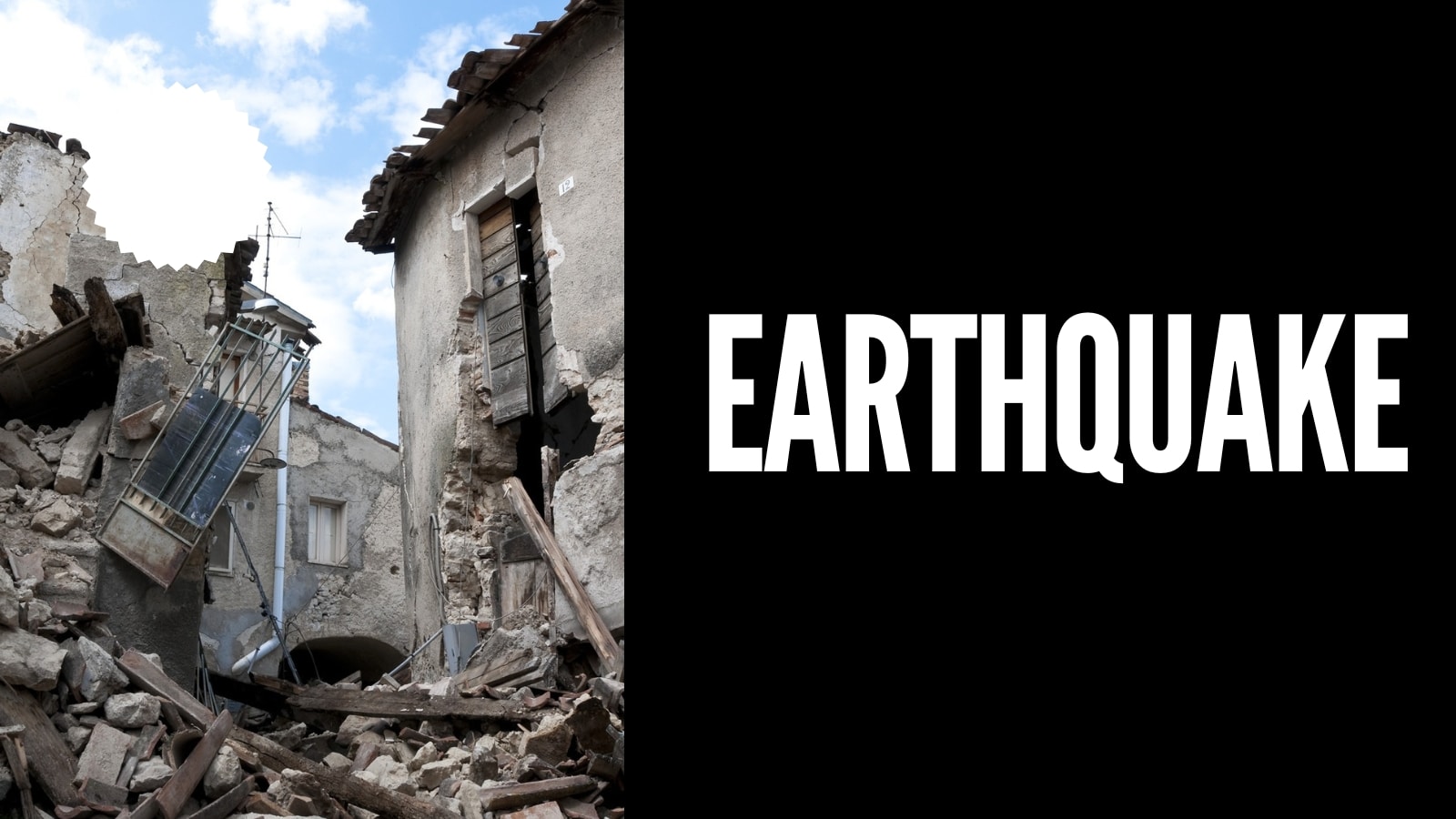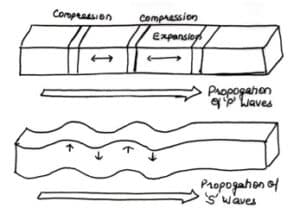
An earthquake is the vibration of Earth produced by the rapid release of energy. Most often earthquakes are caused by slippage along a fault in earth’s crust. The energy released radiates in all directions from its source, the focus, in the form of waves. These waves are analogous to those produced when a stone is dropped into a calm pond. Just as the impact of the stone sets water waves in motion, an earthquake generates seismic waves that radiate throughout Earth. Even though the energy dissipates rapidly with increasing distance from the focus, sensitive instruments located around the world record the event.
Earthquakes and Faults
The tremendous energy released by atomic explosions or by volcanic eruptions can produce an earthquake, but these events are relatively weak and infrequent. Ample evidence exists that Earth is not a static planet. We know that Earth’s crust has been uplifted at times, because we have found numerous ancient wave-cut benches many meters above the level of the highest tides. Other regions exhibit evidence of extensive subsistence. In addition to these vertical displacements, offsets on fence lines, roads, and other structures indicate that horizontal movement is common. These movements are usually associated with large fractures in Earth’s crust called faults.
Most of the motion along faults can be satisfactorily explained by the plate tectonics theory.
This theory states that large slabs of Earth’s crust are in continual slow motion. These mobile plates interact with neighboring plates, straining and deforming the rocks at their edges. In fact, it is along faults associated with plate boundaries that most earthquakes occur. Furthermore, earthquakes are repetitive: as soon as one is over, the continuous motion of the plate’s resumes, adding strain to the rocks until they fail again.
Elastic Rebound
The actual mechanism of earthquake generation eluded geologists until H.F. Reid of Johns Hopkins University conducted a study following the great 1906 San Francisco earthquake.
As slippage occurs at the weakest point (the focus), the displacement will exert stress farther along the fault, where additional slippage will occur until most of the built-up strain is released. This slippage allows the deformed rock to “snap back”.
The vibrations we know as an earthquake occur as the rock elastically returns to its original shape. The “springing back” of the rock was termed elastic rebound by Reid, because the rock behaves elastically, much like a stretched rubber band does when it is released.
In summary, most earthquakes are produced by the rapid release of elastic energy stored in rock that has been subjected to great stress. Once the strength of the rock is exceeded, it suddenly ruptures, causing the vibrations of an earthquake. Earthquakes also occur along existing fault surfaces whenever the frictional forces on the fault surfaces are overcome.
Foreshocks and Aftershocks
The adjustments that follow a major earthquake often generate smaller earthquakes called aftershocks. Although these aftershocks are usually much weaker than the main earthquake, they can sometimes destroy already badly weakened structures. A large aftershock of magnitude 5.8 collapsed many structures that had been weakened by the main tremor.
In addition, small earthquakes called foreshocks often precede a major earthquake by days or, in some cases, by as much as several years. Monitoring of these foreshocks has been used a means of predicting forthcoming major earthquakes, with mixed success.
Seismology
The study of earthquake waves, seismology, dates back to attempts made by the Chinese almost 2000 years ago to determine the direction from which these waves originated. The seismic instrument used by the Chinese was a large hollow jar that probably contained a mass suspended from the top. This suspended mass (similar to a clock pendulum) was connected in some fashion to the jaws of several large dragon figurines that encircled the container. The jaws of each dragon held a metal ball. When earthquake waves reached the instrument, the relative motion between the suspended mass and the jar would dislodge some of the metal balls into the waiting mouths of frogs directly below.
The Chinese were probably aware that the first strong ground motion from an earthquake is directional, and when it is strong enough, all poorly supported items will topple over in the same direction. Apparently the Chinese used this fact plus the position of the dislodged balls to detect the direction to an earthquake’s source. However, the complex motion of seismic waves makes it unlikely that the actual direction to an earthquake was determined with any regularity.
In principle at least, modern seismographs, instruments that record seismic waves, are not unlike the device used by the early Chinese. Seismographs have a mass freely suspended from a support that is attached to the ground. When the vibration from a distant earthquake reaches the instrument, the inertia of the mass keeps it relatively stationary, while Earth and support move. The movement of Earth in relation to the stationary mass is recorded on a rotating drum or magnetic tape.
Earthquakes cause both vertical and horizontal ground motion; therefore, more than one type of seismograph is needed. The instrument is designed so that the mass is permitted to swing from side-to-side and thus it detects horizontal ground motion. Usually two horizontal seismographs are employed, one oriented north-south and the other placed with, an east-west orientation. Vertical ground motion can be detected if the mass is suspended from a spring.
To detect very weak earthquakes, or a great earthquake that occurred in another part of the world, seismic instruments are typically designed to magnify ground motion. Conversely, some instruments are designed to withstand the violent shaking that occurs very near the earthquake source.
The records obtained from seismographs, called seismograms, provide a great deal of information concerning the behavior of seismic waves. Simply stated, seismic waves are elastic energy that radiates out in all directions from the focus. The propagation (transmission) of this energy can be compared to the shaking of gelatin in bowl, which results as some is spooned out. Whereas the gelatin will have one mode of vibration, seismograms reveal that two main groups of seismic waves are generated by the slippage of a rock mass. One of these wave types travels along the outer part of Earth. There are called surface waves. Others travel through Earth’s interior and are called body waves. Body waves are further divided into two types called primary of P waves and secondary or S waves.
Body waves are divided into P and S waves by their mode of travel through intervening materials. P waves are “push-pull” waves – they push (compress) and pull (expand) rocks in the direction the wave is traveling like holding someone by the shoulders and shaking that person. This push-pull movement is how P waves move through Earth.
This wave motion is analogous to that generated by human vocal cords as they move air to create sound. Solids, liquids, and gases resist a change in volume when compressed and will elastically spring back once the force is removed. Therefore, P waves, which are compression waves, can travel through all these materials.
On the other hand, S waves “shake” the particles at right angles to their direction of travel which is like fastening one end of a rope and shaking the other end. Unlike P waves, which temporarily change the volume of intervening material by alternately compressing and expanding it, S waves temporarily change the shape of the material that transmits them. Because fluids (gases and liquids) do not respond elastically to changes in shape, they will not transmit S waves.

The motion of surface waves is somewhat more complex. As surface waves travel along the ground, they cause the ground and anything resting upon it to move, much like ocean swells toss a ship. In addition to their up-and-down motion, surface waves have a side-to-side motion similar to an S wave oriented in a horizontal plane. This latter motion is particularly damaging to the foundations of structures.
Because surface waves are confined to a narrow region near the surface and are not spread throughout Earth as P and S waves are, they retain their maximum amplitude longer. Surface waves also have longer periods (time interval between crests); therefore, they are often referred to as long waves, or L waves.
Seismic waves are useful in determining the location and magnitude of earthquakes. In addition, they provide a tool for probing Earth’s interior.
Go Back